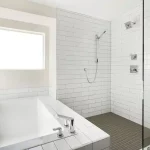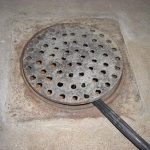Have you ever experienced a clogged drain? It’s a frustrating and unpleasant situation that can happen to anyone. Fortunately, there is a solution: drain cleaner. But how does it work? As someone who has dealt with clogged drains before, I was curious to learn more about how drain cleaner actually unclogs drains.
After doing some research, I discovered that drain cleaners use chemical compounds to dissolve and break down the materials that are clogging the drain. These compounds typically contain high concentrations of chlorine or sulfuric acid, which work to break down the clog. However, not all drain cleaners are created equal, and some may be more effective than others depending on the type of clog and the type of drain.
In this article, I will explore the science behind drain cleaner and how it works to unclog drains. I will also provide some tips on how to use drain cleaner safely and effectively. Whether you’re a homeowner dealing with a clogged sink or a renter looking for a quick fix, understanding how drain cleaner works can help you tackle this common household problem with confidence.
What is Drain Cleaner?
As someone who has dealt with clogged drains before, I have found drain cleaners to be a lifesaver. But what exactly is drain cleaner? In this section, I will explore the different types of drain cleaners and their chemical composition.
Types of Drain Cleaners
There are two main types of drain cleaners: chemical and mechanical. Chemical drain cleaners are the most common and use powerful chemicals to dissolve clogs. Mechanical drain cleaners, on the other hand, use a physical tool to remove the clog.
Chemical Composition
Chemical drain cleaners are typically made up of a combination of strong acids and bases. The most common chemicals used in drain cleaners are sulfuric acid and sodium hydroxide.
These chemicals work by breaking down the clog into smaller pieces, which can then be washed away. It’s important to note that these chemicals can be dangerous if not used properly. Always follow the instructions on the label and wear protective gear such as gloves and goggles.
In conclusion, drain cleaner is a powerful tool that can help remove clogs from your pipes. Chemical drain cleaners use a combination of strong acids and bases to dissolve clogs, while mechanical drain cleaners use physical tools to remove them. When using drain cleaners, always follow the instructions on the label and take proper safety precautions.
How Does Drain Cleaner Work?
As a plumber, I have seen many clogged drains in my career. One of the most common solutions to unclog a drain is to use a drain cleaner. Drain cleaners are chemical compounds that can dissolve the buildup of grease, hair, soap scum, and other materials that can accumulate in pipes. In this section, I will explain how drain cleaners work.
Chemical Reaction
Most drain cleaners contain high concentrations of chemicals such as lye, caustic potash, and bleach. These chemicals work by creating a chemical reaction that can break down the clog. When drain cleaner comes in contact with water, it creates heat and gas that can help dissolve the clog.
The chemical reaction that occurs when using a drain cleaner is exothermic, which means that it releases heat. This heat can help to melt any grease or other materials that are blocking the drain. The gas that is produced can also help to push the clog through the pipe.
Mechanism of Action
The mechanism of action of drain cleaners depends on the type of cleaner used. Some cleaners work by physically removing the clog, while others work by dissolving it. Acid-based cleaners work by dissolving the clog, while alkaline-based cleaners work by breaking it down.
Acid-based cleaners such as sulfuric acid and hydrochloric acid work by dissolving the clog. These cleaners are effective at removing hair and soap scum. However, they can be dangerous to use and can cause damage to pipes if not used properly.
Alkaline-based cleaners such as sodium hydroxide work by breaking down the clog. These cleaners are effective at removing grease and food particles. However, they can also be dangerous to use and can cause damage to pipes if not used properly.
It is important to note that drain cleaners should be used as a last resort. If the clog cannot be removed using a plunger or an auger, then a drain cleaner may be necessary. However, drain cleaners can be harmful to pipes and can cause damage if used improperly. It is always best to consult a professional plumber if you are unsure about how to unclog a drain.
Safety Precautions
When using drain cleaners, it is important to take safety precautions to protect yourself and those around you. Here are some safety tips to keep in mind:
Protective Gear
Wear protective gear, such as safety glasses, rubber gloves, and a face mask, when using drain cleaners. These chemicals can be harmful to your skin, eyes, and mucous membranes. Make sure that your gloves extend beyond your wrists to protect your forearms.
It is also important to wear appropriate clothing when using drain cleaners. Avoid wearing loose-fitting clothing that could get caught in the machinery. Instead, wear close-fitting clothing that will not get in the way.
Storage
Store drain cleaners in a secure location that is out of reach of children and pets. These chemicals can be dangerous if ingested or inhaled. Make sure that the container is tightly sealed and labeled properly to avoid any confusion.
It is also important to keep drain cleaners away from other household chemicals, such as bleach or ammonia. Mixing these chemicals can produce toxic fumes that can be harmful to your health.
Disposal
When disposing of drain cleaners, follow the manufacturer’s instructions carefully. Do not pour these chemicals down the drain or toilet, as they can damage your plumbing and harm the environment. Instead, take them to a hazardous waste disposal facility or contact your local waste management company for guidance.
Never reuse drain cleaners or mix different types of drain cleaners together. Doing so can produce dangerous chemical reactions that can cause serious injury or damage to your home.
Alternatives to Drain Cleaner
While drain cleaners can be effective in unclogging drains, they can also be harsh and potentially harmful to the environment. Fortunately, there are several alternatives to drain cleaner that can be just as effective.
Plunger
One of the most common alternatives to drain cleaner is a plunger. It works by creating suction in the drain, which can dislodge clogs and allow water to flow freely again. To use a plunger, place it over the drain and push down gently, then pull up quickly. Repeat this motion several times until the clog is cleared.
Plumbing Snake
Another alternative to drain cleaner is a plumbing snake, also known as a drain auger. This tool works by inserting a long, flexible cable into the drain and rotating it to break up clogs. To use a plumbing snake, insert the cable into the drain and turn the handle to rotate it. Continue rotating the cable until the clog is cleared.
It’s important to note that while a plumbing snake can be effective, it can also cause damage to pipes if used incorrectly. If you’re not comfortable using a plumbing snake, it’s best to call a professional plumber.
Other alternatives to drain cleaner include baking soda and vinegar, which can be poured down the drain and left to sit for several hours before being flushed with hot water. Enzymatic drain cleaners, which use natural bacteria to break down clogs, are another option.
When choosing an alternative to drain cleaner, it’s important to consider the severity of the clog and the type of pipes in your home. Some alternatives may be more effective than others depending on the situation.



